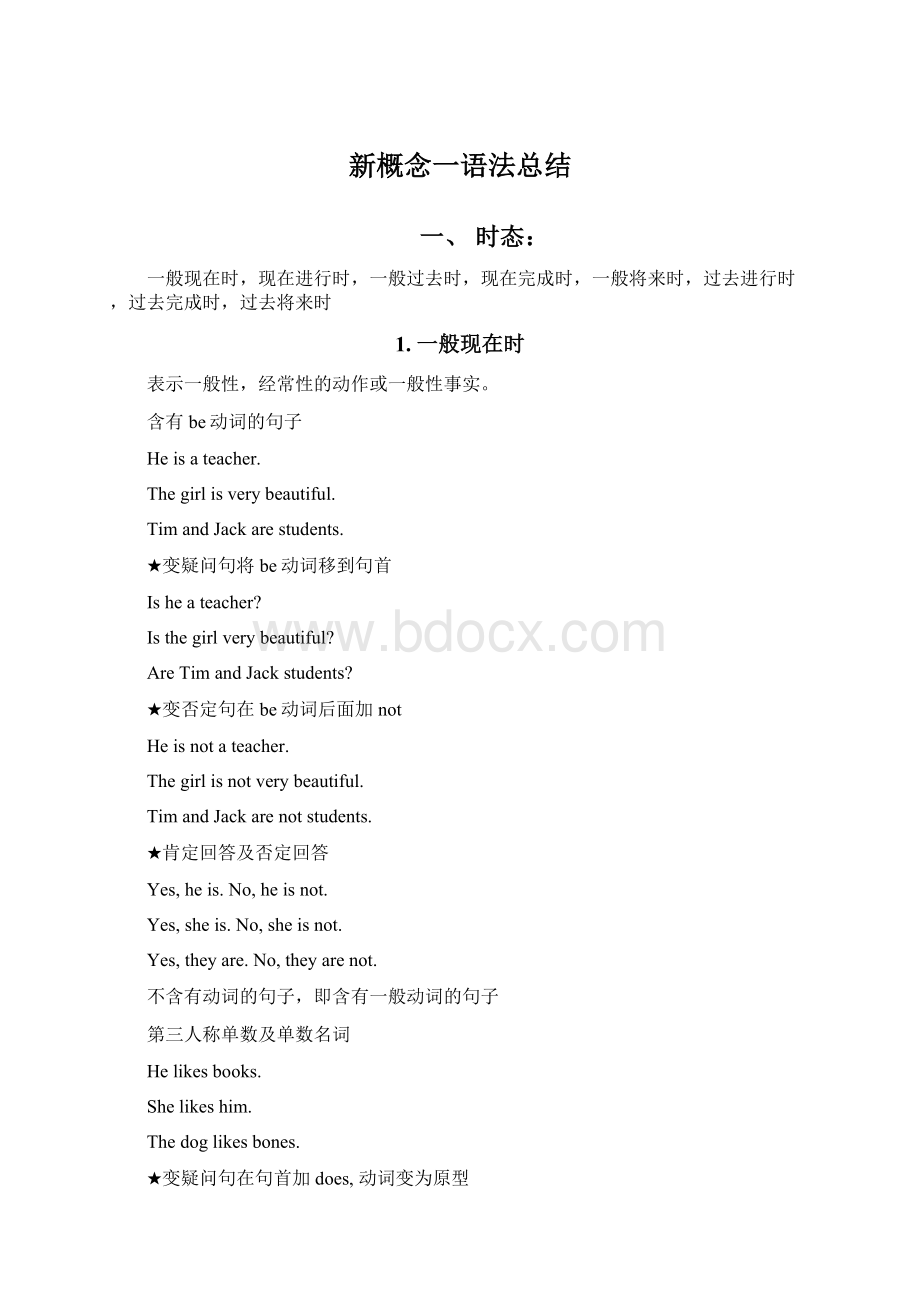新概念一语法总结.docx
《新概念一语法总结.docx》由会员分享,可在线阅读,更多相关《新概念一语法总结.docx(19页珍藏版)》请在冰豆网上搜索。

新概念一语法总结
一、时态:
一般现在时,现在进行时,一般过去时,现在完成时,一般将来时,过去进行时,过去完成时,过去将来时
1.一般现在时
表示一般性,经常性的动作或一般性事实。
含有be动词的句子
Heisateacher.
Thegirlisverybeautiful.
TimandJackarestudents.
★变疑问句将be动词移到句首
Isheateacher?
Isthegirlverybeautiful?
AreTimandJackstudents?
★变否定句在be动词后面加not
Heisnotateacher.
Thegirlisnotverybeautiful.
TimandJackarenotstudents.
★肯定回答及否定回答
Yes,heis.No,heisnot.
Yes,sheis.No,sheisnot.
Yes,theyare.No,theyarenot.
不含有动词的句子,即含有一般动词的句子
第三人称单数及单数名词
Helikesbooks.
Shelikeshim.
Thedoglikesbones.
★变疑问句在句首加does,动词变为原型
Doeshelikebooks?
Doesshelikehim?
Doesthedoglikebones?
★变否定句在主语及动词之间加doesn’t,动词变为原型
Hedoesn’tlikebooks.
Shedoesn’tlikehim.
Thedogdoesn’tlikebones.
★肯定回答及否定回答:
Yes,hedoes.No,hedoesn’t.
Yes,shedoes.No,shedoesn’t
Yes,itdoes.No,itdoesn’t.
注意:
第三人称单数形式一般在动词后面加S,不要和名词复数混淆,变否定句或疑问句时名词复数没有任何变化。
其他人称及复数名词
Iwanttohaveabath.
Wehavesomemeat.
Thestudentslikesmartteachers.
★变疑问句在句首加do
Doyouwanttohaveabath?
Dowehaveanymeat?
Dothestudentslikesmartteachers?
★变否定句在主语和动词之间加don’t.
Youdon’twanttohaveabath.
Wedon’thaveanymeat.
Thestudentsdon’tlikesmartteachers.
★肯定回答及否定回答
Yes,Ido.No,Idon’t.
Yes,wedo.No,wedon’t
Yes,theydo.No,theydon’t.
2.现在进行时
表示现在正在进行的动作。
构成:
主语+be动词+动词的现在分词+其它成分(现在分词的构成见附录)
Wearehavinglunch.
Heisreadingabook.
Thedogisrunningafteracat.
Theboysareswimmingacrosstheriver.
★变疑问句将be动词移到句首
Arewehavinglunch?
Ishereadingabook?
Isthedogrunningafteracat?
Aretheboysswimmingacrosstheriver?
★变否定句在be动词后面加not
Wearenothavinglunch.
Heisnotreadingabook.
Thedogisnotrunningafteracat.
Theboysareswimmingacrosstheriver.
★特殊疑问句:
what,which,how,where,who,etc.
疑问词+动词+主语+现在分词
Whatareyoudoing?
Whatisshedoing?
Whatisthedogdoing?
没有进行时的动词
表示状态,思想,感情和感觉的动词不能表示正在进行的动作
1.表示感觉,感官的词
see,hear,like,love,want,
2.have,has当”拥有”讲时没有进行时
3.一般过去时
表示过去发生的动作或事件,
常和表示过去的时间状语连用,如yesterday,lastnight,thedaybeforeyesterday,3daysago,
含有be动词的句子,将动词变为过去式,am,is的过去式为was,are的过去式为were
Iwasatthebutcher’s.
Youwereastudentayearago.
Theteacherwasverybeautifultenyearsago.
★变疑问句将be动词移动到句首
Wereyouatthebutcher’s?
Wereyouastudentayearago?
Wastheteacherverybeautifultenyearsago?
★变否定句在be动词后面加not
Iwasnotatthebutcher’s.
Youwerenotastudentayearago.
Theteacherwasnotverybeautifultenyearsago.
★肯定回答否定回答
Yes,Iwas.No,Iwasnot.
Yes,youwere.No,youwerenot.
Yes,he/shewas.No,he/shewasnot.
★特殊疑问句:
Whatdidyoudo?
不含有be动词的句子,将动词变为过去式,动词过去式构成见附录
Ifinishedmyhomeworkyesterday.
Theboywenttoarestaurant.
TheSawyerslivedat
KingStreet
ayearago.
★变疑问句在句首加did,
动词变为原型
Didyoufinishyourhomeworkyesterday?
Didtheboygotoarestaurant?
DidtheSawyersliveat
KingStreet
ayearago?
★变否定句在主语和动词之间加didnot
Ididnotfinishmyhomeworkyesterday.
Theboydidnotgotoarestaurant.
TheSawyersdidnotliveat
KingStreet
ayearago.
★肯定回答及否定回答
Yes,Idid.No,Ididn’t.
Yes,hedid.No,hedidn’t.
Yes,theydid.No,theydidnot.
4.现在完成时
构成:
主语+助动词have,has+过去分词
用法:
1)表示过去发生的和现在有某种联系的动作,常和just,usually,already,since等时间副词连用
Ihavejusthadlunch.(饱了,不用再吃了)
Hehashadacupoftea.(不渴了,不用再喝)
Theyhavealreadyhadtheirholiday.(不能再度假了)
Theboyhasalreadyreadthebook.(已经知道书的内容了,不用再看了)
2)询问别人是否做过某事一般用现在完成时:
Haveyoufinishedyourhomework?
HaveyoubeentoBeijing?
Haveheseenthefilm?
3)表示开始于过去并持续到现在的动作
IhavelivedinBeijingfortwentyyears.
Ihaveworkedforthisschoolfor1year.
4)表示一种经历,经验:
去过…地方,做过…事情,经历过…事情
Ihaveneverhadabath.
Ihaveneverseenafilm.
Ihaveneverbeentocinema.
IhaveeverbeentoParis.
Havebeento表示去过,havegoneto表示去了
IhavebeentoLondon.(人已经回来)
HehasgonetoLondon.(人还在那里)
5)表示一种结果,
一般不和时间副词联用
Ihavelostmypen.
Ihavehurtmyself.
Hehasbecomeateacher.
Shehasbrokenmyheart.
句型变化:
★变疑问句将助动词移到句首,变否定句在助动词后面加not.
e.g.Haveyoulostyourpen?
Ihavenotlostmypen.
★肯定回答及否定回答
Yes,Ihave.No,Ihavenot.
★特殊疑问句:
Whathaveyoudone?
Whathashedone?
一般过去时与现在完成时的区别:
凡是有明确的表示过去的时间状语的句子为过去时
注意:
有些动词表示的动作有一个终点,不能再延续,因此不能和表示一段时间状语连用
错:
I’veleftBeijingfor3days.
对:
IleftBeijing3daysago.Ihavebeenawayfrombeingfor3days.
5.一般将来时
表示将来将要发生的动作,
经常和tomorrow,nextyear,thedayaftertomorrow,theyearafterthenext,infivehours’time,etc.表示将来的词联用
结构:
主语+助动词will+动词原形
IwillgotoAmericatomorrow.
ThepilotwillflytoJapanthemonthafterthenext.
Jackwillmoveintohisnewhousetomorrowmorning.
★变疑问句将助动词移到句首
WillyougotoAmericatomorrow?
WillthepilotflytoJapanthemonthafterthenext?
WillJackmoveintohisnewhousetomorrowmorning?
★变否定句在助动词后面加not
IwillnotgotoAmericatomorrow.
ThepilotwillnotflytoJapanthemonthafterthenext.
Jackwillnotmoveintohisnewhousetomorrowmorning
★肯定回答及否定回答
Yes,Iwill.No,Iwillnot.
Yes,he/shewill.No,he/shewillnot.
Yes,hewill.No,hewillnot.
二、特殊句型:
therebe句型,begoingto结构
1.Begoingto结构
表示打算,准备,计划做某事
★结构:
主语+be动词+goingto+动词原型
Iamgoingtomakeabookcase.
Theyaregoingtopaintit.
Thefatherisgoingtogivethebookcasetohisdaughter.
★变疑问句将be动词移到句首
Areyougoingtomakeabookcase?
Aretheygoingtopaintit?
Isthefathergoingtogivethebookcasetohisdaughter?
★变否定句在be动词后面加not
Iamnotgoingtomakeabookcase.
Theyaregoingtopaintit.
Thefatherisnotgoingtogivethebookcasetohisdaughter.
★肯定回答及否定回答
Yes,Iam.No,Iamnot.
Yes,theyare.No,theyarenot.
Yes,heis.No,heisnot.
★特殊疑问句
Whatareyougoingtodo?
Whataretheygoingtodo?
Whatisthefathergoingtodo?
(必背)
2.Therebe句型
表示哪里有什么东西(某处有某物)
uThereis+单数名词+表示场所的词(一般为介词词组)
Thereisabookinthisroom.
Thereisapenonthetable
uThereare+复数名词+表示场所的词(一般为介词词组)
Therearetwopensonthetable.
Therearethreeschoolsthere.
★变疑问句将be动词移到句首
Isthereabookinthisroom?
Aretheretwopensonthetable?
★变否定句在动词后面加not
Thereisnotabookinthisroom.
Therearenottwopensonthetable.
★肯定回答及否定回答
Yes,thereis.No,thereisnot.
Yes,thereare.No,therearenot.
三、问句:
一般疑问句,特殊疑问句,选择疑问句,反意疑问句,选择疑问句,否定疑问句
一般疑问句:
助动词/be动词+主语
Areyouateacher?
Doyouwanttohaveacupoftea?
特殊疑问句:
特殊疑问词+一般疑问句
Whatisyourname?
选择疑问句:
or
Doyouwantbeeforlamb?
反意疑问句:
肯定陈述句+否定疑问部分,
否定陈述部分+肯定疑问部分
Youdon’tneedthatpen,doyou?
否定疑问句:
一般疑问句+否定词
Aren’tyoulucky?
Don’tyouwanthavearest?
四、冠词用法:
a/an/the的一般用法
详细见笔记
五、限定词:
some,any,many,much
some,any修饰可数名词或不可数名词,some用于肯定句,any用于否定句和疑问句,注意,当期待对方的答案为肯定回答时用some
many修饰可数名词,much修饰不可数名词,在口语中表示很多一般不用many,much,而用alotof,在否定句中表示很多用many,much.
Ihavealotofmoney.Idon’thavemuchmoney.
六、名词:
种类,复数,名词所有格
1.名词分为可数名词和不可数名词
不可数名词
无法分开的东西:
water,tea,bread,milk,rice(米)
抽象的东西:
love,beauty,coldness(寒冷)
不可数名词有以下特点:
不能用a,an修饰
不能加s
和单数be动词或动词搭配
可数名词:
单数可数名词要用冠词修饰,复数可数名词要在名词后面加s,名词复数共有以下几种变化:
七、介词(注意总结书上词组)
八、副词:
用法及形容词变副词的变化
u副词可以修饰形容词,动词,副词或整个句子。
如:
Thebookisverygood.
Herunsfast.
Shecameherequiteearly.
CertainlyIwillgowithyou.
u变化:
1.直接在形容词后加-ly,
careful-carefully,slow-slowly,
2.以辅音字母加y结尾的形容词,把y变I,加-ly,
happy-happily,lucky-luckily
3.有些词形容词和副词的形式相同,不需要做任何变化
fast,hard,late
4.有些词加上-ly后意思与原词相差很远:
neary-nearly,high-highly,late-lately,
九、情态动词的使用:
can,must,may,might,need,
1.情态动词can(能够),must(必须),may(可以)
结构:
主语+can/must/may+动词原型
Hecanmakethetea.
Sallycanairtheroom.
WecanspeakEnglish.
★变疑问句将情态动词移到句首
Canhemakethetea?
CanSallyairtheroom?
CanwespeakEnglish?
★变否定句在情态动词后面加not
Hecannotmakethetea.
Sallycannotairtheroom.
WecannotspeakEnglish.
★肯定回答及否定回答
Yes,hecan.No,hecannot.
Yes,shecan.No,shecannot.
Yes,wecan.No,wecannot.
★特殊疑问句:
Whatcanyoudo?
(必背)
注意:
情态动词的句子没有第三人称单数的变化,不要在情态动词或动词后面加S。
2.Must/haveto的区别
must表示必须,是主观上觉得应该做,haveto是不得不,是由于客观条件逼迫的必要要做
must只能用在表示现在和将来的句子里,而havetodo可以用在任何时态
3.must,may,might表示猜测:
umustdo表示对现在事实的猜测
umusthavedone表示对过去事实的猜测
umusthavebeendoing表示对过去正在进行的事实的猜测
umay/mightdo,may/mighthavedone表示没有任何事实依据的猜测,might的可能性更小。
ucan’t/couldn’t表示不可能
4.need用法:
u表示“需要”时为实意动词,后面可以加名词,也可以加不定式:
Ineedapen.Doyouneedanybeer?
No,Idon’t.
Ineedtohavearest.
uNeeddoing=needtobedone,表示被动
Theflowersneedwatering.
uNeed在否定时做情态动词使用
Youneedn’tgosoearly.=Youdon’tneedtogosoearly.
MustIcleanthedeskrightnow?
No,youneedn’t.
一十、不定代词及不定副词:
bookeverywhere,butIcan’tfinditanywhere.
Ifyouwantgosomewhere,ifyouwanttobesomeone,youmustwakeup.
Help!
Somebody?
Anybody?
Youarereallysomething.
Sinceeverybodyishere,let’sbeginourclass.
Wheredidyougo?
Iwentnowhere.
Nobodyisathome.
Ihavenothingleft.
一十一、感叹句:
uWhat+名词+主语+谓语
Whatabeautifulgirlsheis!
uHow+形容词+主语+谓语
Howbeautifulthegirlis!
一十二、祈使句:
l第二人称:
llet+其他人称代词
l祈使句的否定,加don’t
l反意疑问
祈使句(第二人称)
祈使句表示请求,命令,建议,邀请等,谓语动词一律用原型,句子中通常不用主语,句末用惊叹好或者句号,用降调。
★肯定句
动词原型
例,Comehere,please.Godownstairs,please.Standup.Sitdown.Bequiet.Becareful.
祈使句中如果有唤语,一定要用逗号隔开,放在句首或者句尾
Comein,Amy.
Sitdownhere,Tom.
Mary,givemeabookplease.
★否定:
Don't+动词原型
Don'tcomehere.
Don’tsitdown.
Don’tstandup.
Don’tgivemeit.
letsb.do
Letmepass.
Letushavearest.
Let’shavearest.
(反意疑问):
Let’shaveawalkalongtheriver,shallwe?
Letusgooutforadrink,willyou?
一十三、倒装句:
so/neither的倒装eg.
Hecanswim.SocanI.
Ididn’tgotoclass.NeitherdidI.
结构:
so/neither+be+主语
so/neither+助动词+主语
so/neither+情态动词+主语
一般现在时,do,does/am,is,are
现在进行时,am,is,are
一般过去时,did
现在完成时,have,has
一般将来时,will,s